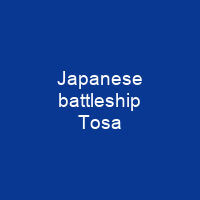Tosa was a planned battleship of the Imperial Japanese Navy. Designed by Yuzuru Hiraga, she was envisioned as the lead ship of the Tosa class of two 39,900-long-ton ships. All work on the ship was halted after the Washington Naval Conference and the signing of the Washington naval Treaty. The incomplete Tosa was then subjected to various tests to gauge the effect of Japanese weaponry before being scuttled in 1925.
About Japanese battleship Tosa in brief

The rest of her guns were placed in reserve and ultimately scrapped in 1943. She utilized the same slipway where, two decades later, the Yamato-class battleship Musashi would be built. She was originally scheduled to be launched in October 1921, but multiple strikes delayed it until November. Ultimately, the battleship was not launched until 18 December 1921, two months behind schedule. Fitting-out commenced soon after with a projected completion date of July 1922. The ship was designated for use in testing the effectiveness of shells and torpedoes against its armor arrangements. In June 1924 the navy’s gunnery school took possession of the hull and prepared it for testing. The first involved a 100 kg Mk. I mine placed on the starboard side of the ship, 3. 7 m below the waterline at frame 57. The resultant explosion ruptured about 22 m2 of hull, while dishing in another 750 sq ft of plating.
You want to know more about Japanese battleship Tosa?
This page is based on the article Japanese battleship Tosa published in Wikipedia (as of Dec. 08, 2020) and was automatically summarized using artificial intelligence.







